Top Workday Training Institutes in Bengaluru near me
Workday Prism Analytics Course in Bengaluru
Workday Prism Analytics allows access to its published data source only if its underlying dataset has an appropriate access configuration; that means only users with access can utilize its published form.
This approach is straightforward and security-oriented, providing implicit protection provided by Workday Prism Analytics.
Maximizing Workday Prism Analytics Employee Base Salary Insights
Are You Wondering How to Unlock Valuable Insights Regarding Employee Base Salaries Using Workday Prism Analytics? Here is a step-by-step overview.
To determine the maximum base salary of employees by gender, first click ‘Add Field’ and select the Max function from among available window functions such as Max, Min, Average etc.
Max was selected to calculate the maximum base salary of employees at each supervisory organization in Workday Prism Analytics Course in Bengaluru easily and effortlessly, using selection of supervisory organization names as groups to group data before sorting results descending by employee base salary.
Just a few clicks can reveal the maximum base salary for employees within each supervisory organization arranged beautifully.
Add gender as a partitioning field to gain further insights, and calculate maximum base salaries separately for male and female employees within each supervisory organization.
Workday Prism Analytics’ users will marvel at its incredible power to delve into data with such precision.
However, sometimes null values appear in results and to prevent this, create a Public Data Source (PDS). A PDS will ensure no null values exist within its data.
Workday Prism Analytics stands out from its competition thanks to this innovative feature – using PDS can further refine analysis without null values becoming clutter.
Grouping by supervisory organization and gender also categorizes data effectively within Workday Prism Analytics.
Supervisory organizations like IT Services Group use partitioned calculations of maximum base salaries separately for male and female employees in order to provide an in-depth view of data analysis.
This ensures each group can be studied separately while still giving an overall picture.
Workday Prism Analytics goes even further! With its rich functionality for calculated fields – numeric or decimal values alike – Workday Prism Analytics Course in Bengaluru provides user-friendly tools that let them customize analysis with ease.
Workday Prism Analytics makes formatting decimals to two decimal places easy in calculated fields using built-in functions; even complex calculations become straightforward thanks to this program’s ease.
Workday Prism Analytics’ community access provides users with ample examples and uses cases, from window functions and calculations, through null values management and dealing with window functions themselves. Assuring their analytical needs are fulfilled without difficulty.
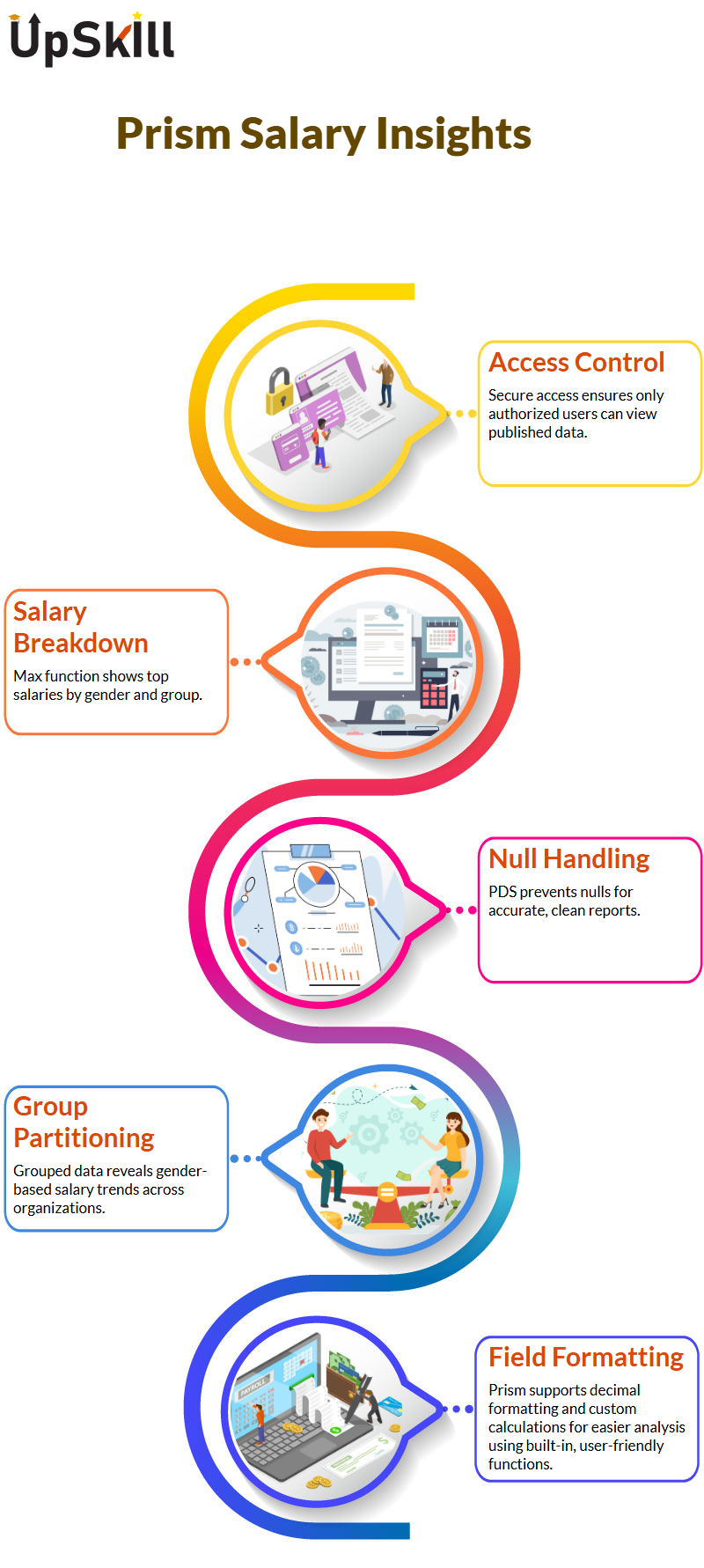
Data Management Workday Prism Analytics
Working with Workday Prism Analytics makes it clear how important modifications must be executed efficiently in order to stay compliant, including adding managed field stages that take on calculations efficiently.
Although calculated fields could have been created during the join phase, managing all processes separately helped expedite this step of the process. For professionals who want to master these techniques, Workday Prism Analytics Course in Bengaluru offers a practical path to develop these skills.
In one instance, fields like Age on Hire and Employee Base Pay Amount had unnecessary decimal places up to 10 which needed to be addressed as quickly as possible.
Utilising Workday Prism Analytics, numeric values were swiftly selected and adjusted so there were only two decimal places displayed, which provided clarity and relevance at once.
How Workday Prism Analytics Enhances Reporting?
Workday Prism Analytics also simplified how numeric configurations were managed; some fields previously showed six or seven decimal places unnecessarily.
One project involved creating scorecards using Workday Prism Analytics Course in Bengaluru to gather insights such as headcount, gender ratios and employee types.
They served an essential function by summarizing key metrics that enabled teams to make data-driven decisions.
Workday Prism Analytics Enhances Reporting
In one project, scorecards were constructed through composite reporting using Workday Prism Analytics.
Specific metrics, such as termination counts, employee assignments and age-based groupings could easily be defined using this analytics software solution.
Workday Prism Analytics Course in Bengaluru equips professionals with the skills needed to effectively build and manage such metrics using advanced reporting techniques.
Case functions were employed for gender-related counts to help simplify data summarization, for example ‘Case when male, then one.
Workday Prism Analytics made creating and publishing accurate metrics easy and ensured the team had access to accurate insights across their organization.
Workday Prism Analytics Dashboards
Workday Prism Analytics Dashboards Create numeric values using Workday Prism Analytics is exciting and provides opportunities to create scorecards as metrics reports to effectively track and manage data.
Calculations can be presented through composite reports that provide an overall view of trends such as headcount.
Workday Prism Analytics makes creating dashboards an effortless process. Once a client requests a scorecard, the first step involves uploading relevant data into Prism’s environment – an essential step that provides summaries and provides meaningful insights for an organization’s overall development.
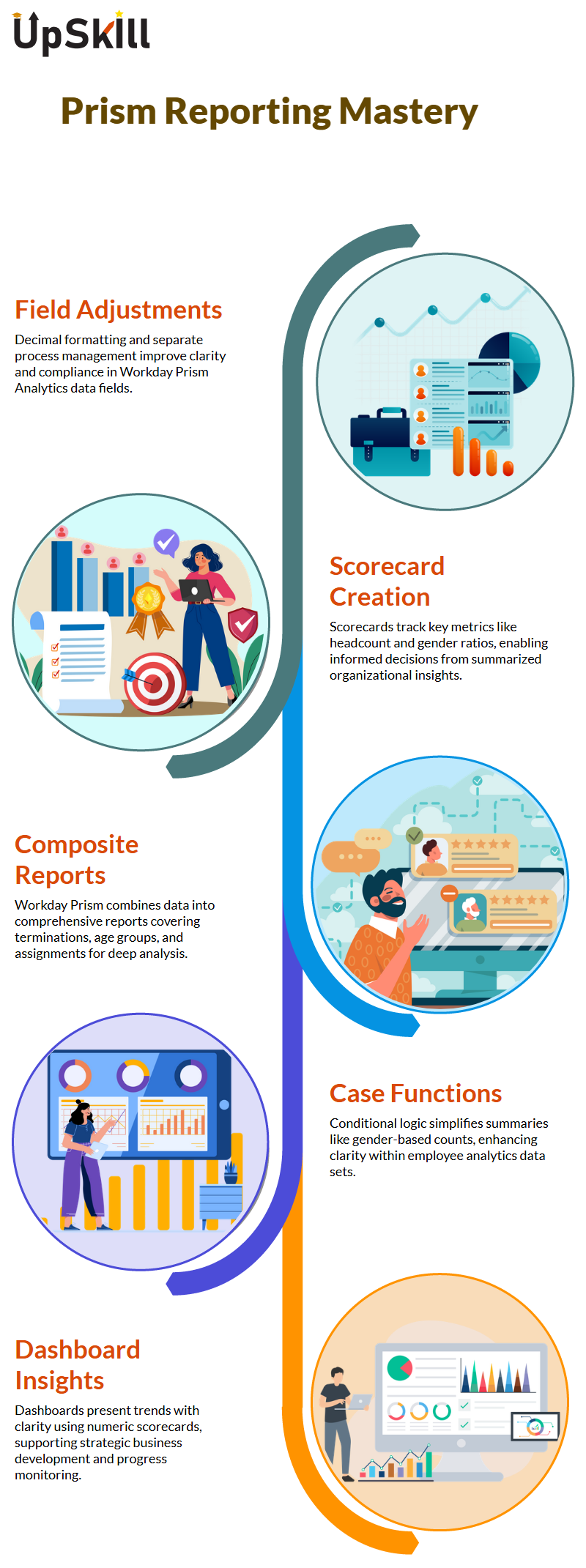
Workday Prism Analytics Scorecards
Workday Prism Analytics Scorecards are one of the stands-out features of Workday Prism Analytics Course in Bengaluru, providing high-level trends such as counts and summarizations which can be customized according to client specific requirements.
When clients request summations, collaboration occurs to identify and define necessary metrics before bringing this data into Prism for analysis.
Consider headcount: this can be calculated through creating a simple matrix report in Workday Prism Analytics, while multiple matrices provide an effective means of visualizing and analyzing numeric data.
Note, though, that summarizations can only apply to numerical values; not attributes like gender.
Security Features in Workday Prism Analytics
When custom reports are initially created, security settings are applied so only authorized users are able to view specific data.
Contextual security ensures that users only see data relevant to them; however, when data enters Workday Prism Analytics it can alter this paradigm drastically.
Accessing a base dataset allows viewing all available information even if not accessible via custom reports; this demonstrates the significance of safeguarding datasets within Workday Prism Analytics Course in Bengaluru environment.
Working day Prism Analytics also features an effective Five-Phase Process which ensures all required steps for data access are followed properly.
Workday Prism Analytics features an easy five-phase process designed for effortless use. After data has been uploaded into its base dataset, derived datasets are easily created, transformed data is transformed again before security controls are applied and finally published for publication and finally analysed to provide real business value.
Workday’s security model applies closely in each phase. For example, during the first two steps (creation/editing datasets and security/analysis respectively), Workday applies its security model meticulously.
Eventually in subsequent phases it focuses more on security analysis.
Metadata and Datasets in Workday Prism Analytics
In Workday Prism Analytics, metadata plays an integral part in creating datasets.
At its heart is its schema, field types, order and format in addition to example rows that illustrate its contents – providing access control is equally vital in that only users who possess access can see both its definition and subset of data.
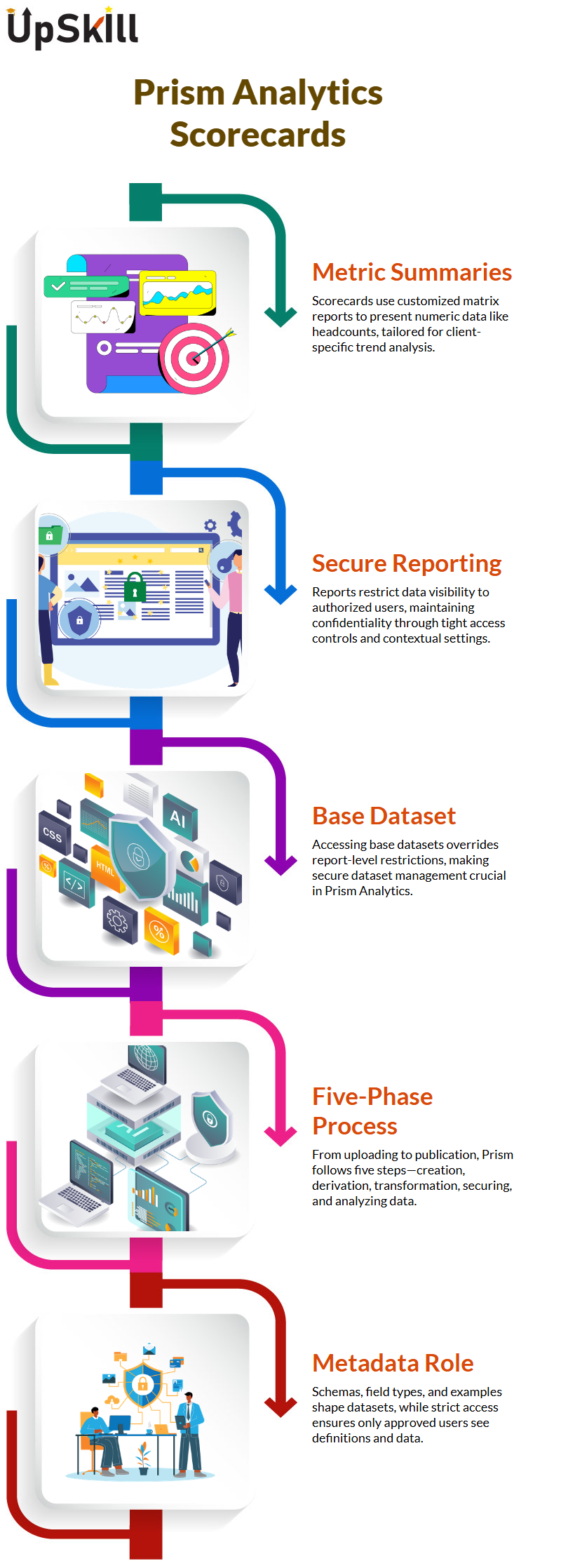
Workday Prism Analytics for Data Access
Let’s walk through Workday Prism Analytics and how it allows control over accessing specific datasets.
Once access has been granted to a data set, metadata and rows within it can be seen; but controlling who has access becomes much more challenging.
Workday Prism Analytics allows administrators to configure security domains that determine who can create, view and/or manage data sets. Without proper permission a user cannot see its contents; making sense!
This approach ensures data stays secure while giving only those who require access to it access it.
Workday Prism Analytics and Data Set Sharing
With Workday Prism Analytics’ Data Share feature, dataset owners have total control over who accesses their dataset – whether only viewing access is granted, editing rights granted or no edit access allowed at all.
Workday Prism Analytics’ powerful feature lies in its ability to ensure clear data ownership while offering different levels of access for collaboration purposes, be that through view mode or edit mode.
Applying Workday Prism Analytics Security
Workday Prism Analytics boasts an additional useful capability: its ability to secure published data.
While data sets themselves remain unrestricted, restrictions are automatically added when publishing data sources based on publication – an approach which aligns well with organizational global security strategies.
Users and security teams have access to make adjustments as necessary; designing security frameworks in Workday Prism Analytics is both intuitive and efficient; its primary goal remains preserving data security while still permitting appropriate access for designated individuals.
Workday Prism Analytics in Action
No matter where the data comes from – be it from custom reports, an SFTP file, or another source – Workday Prism Analytics allows all authorized users access.
Even without access to its source, data sets provide ample opportunity for exploration and analysis of information.
With Workday Prism Analytics simplifying this process by eliminating unnecessary restrictions from data sets while offering precise control over who can view or manage them, as well as access control over them all.
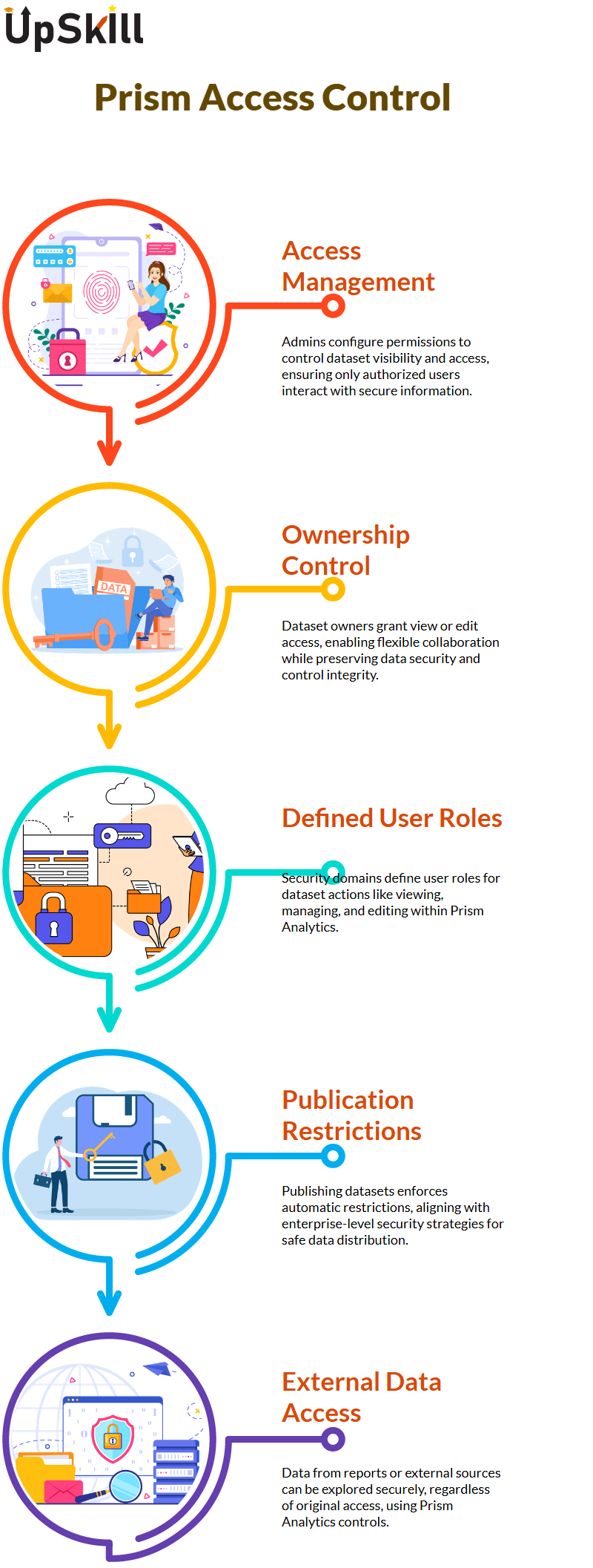
Workday Prism Analytics Security
Workday Prism Analytics Security When working with Workday Prism Analytics, maintaining proper security measures for published data is of utmost importance.
The platform automatically applies security restrictions to data you publish, ensuring it meets any restrictions when seen within reports generated from it.
Any restrictions will only ever apply within these reports generated from it.
As you use Workday Prism Analytics, you’ll discover data visualizations and advanced reports which make interpreting data much simpler.
Once data has been published, it becomes part of a Prism Data Source in Workday and secure access only by authorized viewers is ensured.
Publishing Data in Workday Prism Analytics
Let’s investigate what happens when publishing data within Workday Prism Analytics. Let’s assume we have an example dataset, DDS-01, with all necessary fields but has yet to be made live for publication.
Even without explicit security policies in place for this dataset, Workday implements implicit protection called ‘Prism Default to Data Set Access”.
Even without explicit security groups in place, Workday ensures basic domain-level protection is applied to your Prism Data Sources by default – giving access only to individuals who possess sufficient permissions.
Workday Prism Analytics Applies Security
When publishing data in Workday Prism Analytics, several key actions take place. First, Workday generates a Prism Data Source similar to its other delivered sources.
As soon as your transformed data from your dataset has been imported into this data source, the application of security restrictions takes place.
Even without explicit application of such security controls, Workday ensures that implicit security exists on its Prism Data Sources.
The default security setting, Prism Default to Data Set Access, ensures that only authorized users can view data.
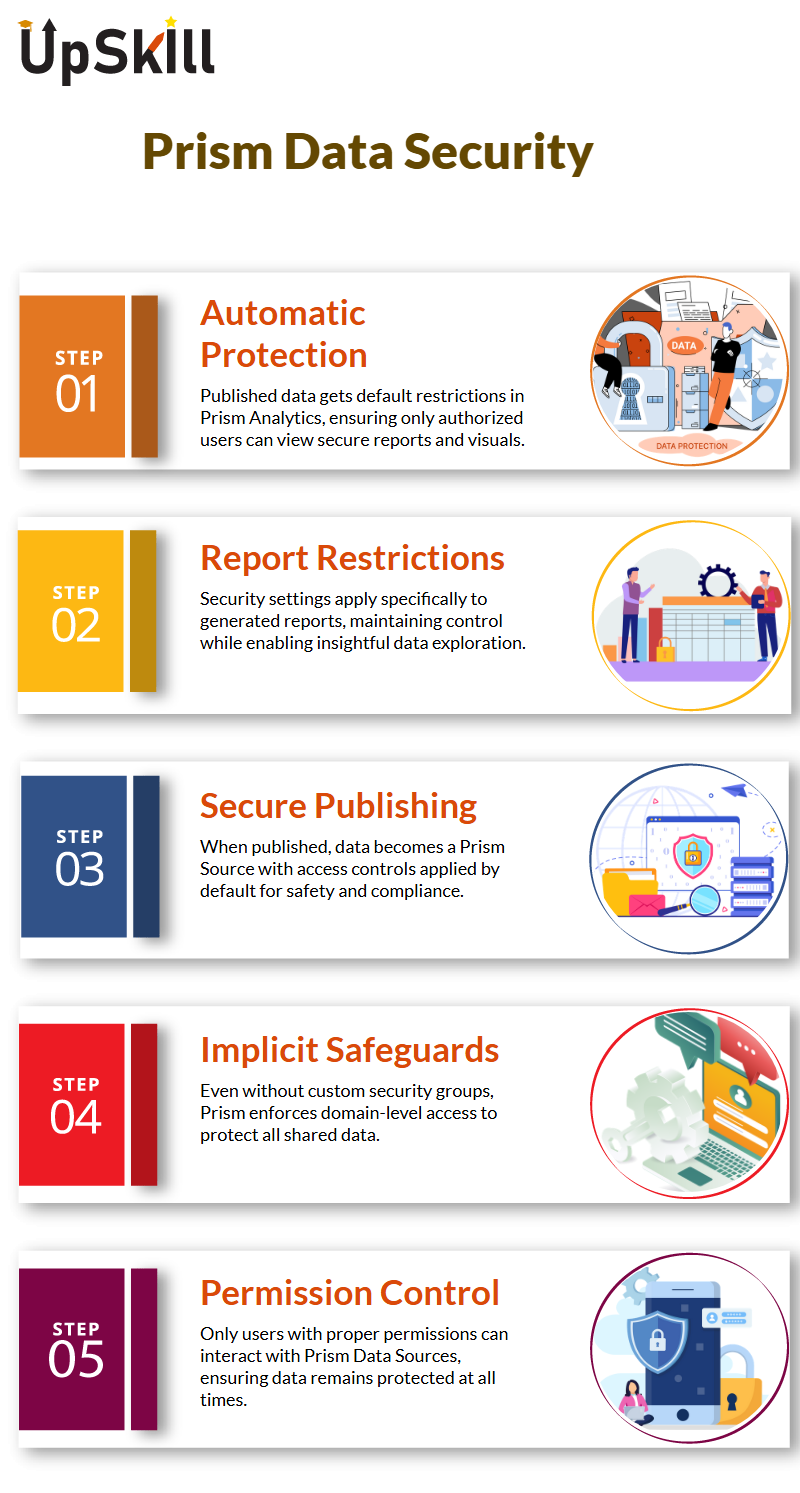
Security Layers in Workday Prism Analytics
Workday Prism Analytics Provides Multiple Layers of Security For your data; Workday creates and loads into a Prism Data Source transformed data along with required security measures by default.
Workday Prism Analytics ensures a safe environment for your analytics needs by employing implicit domain security settings that protect against potential risks, like “Prism Default to Data Set Access.”
With these settings activated only those with access to an underlying dataset can view its Prism Data Sources.
Ultimately this ensures you a more effective use of Workday’s Prism Analytics tools.
Workday Prism Analytics Security
First is individual data set security; secondly is security in relation to published data sources. When controlling access to either base or derived datasets, managing roles and permissions becomes imperative.
As part of Workday Prism Analytics’ data set sharing feature, data set owners may allow others to view, create, manage or access their datasets through additional actions and security settings.
When sharing their datasets publicly or with third party analytics platforms (for instance Workday Analytics or R), as an owner you have additional permissions and settings available to share datasets more widely than ever before – for instance.
Workday allows this directly through additional security options available via Workday Connected Cloud or Prism Analytics Admin Consoles (via Workday Prism Analytics Connector or R Analytics Connector), sharing may happen through additional actions or security settings as the owner can share datasets publicly based on additional actions and security settings as appropriate datasets.
Sharing Workday Prism Analytics Datasets
Sharing datasets is an integral component of Workday Prism Analytics that gives users control over access.
If Steve Morgan wishes to share one with another user, access levels can be set so as to allow viewing, editing or transfer of ownership of that dataset.
Individuals or security groups can assign permissions in Workday Prism Analytics similar to what Google Drive allows;
Role-Based Workday Prism Analytics Security
Workday Prism Analytics’ security is dependent on assignable roles; their presence identifies who can gain entry to datasets.
Data analysts should assign roles like dataset viewer, editor or owner when assigning them roles within Workday Prism Analytics in order to distribute permissions accordingly and share datasets safely among all of its members.
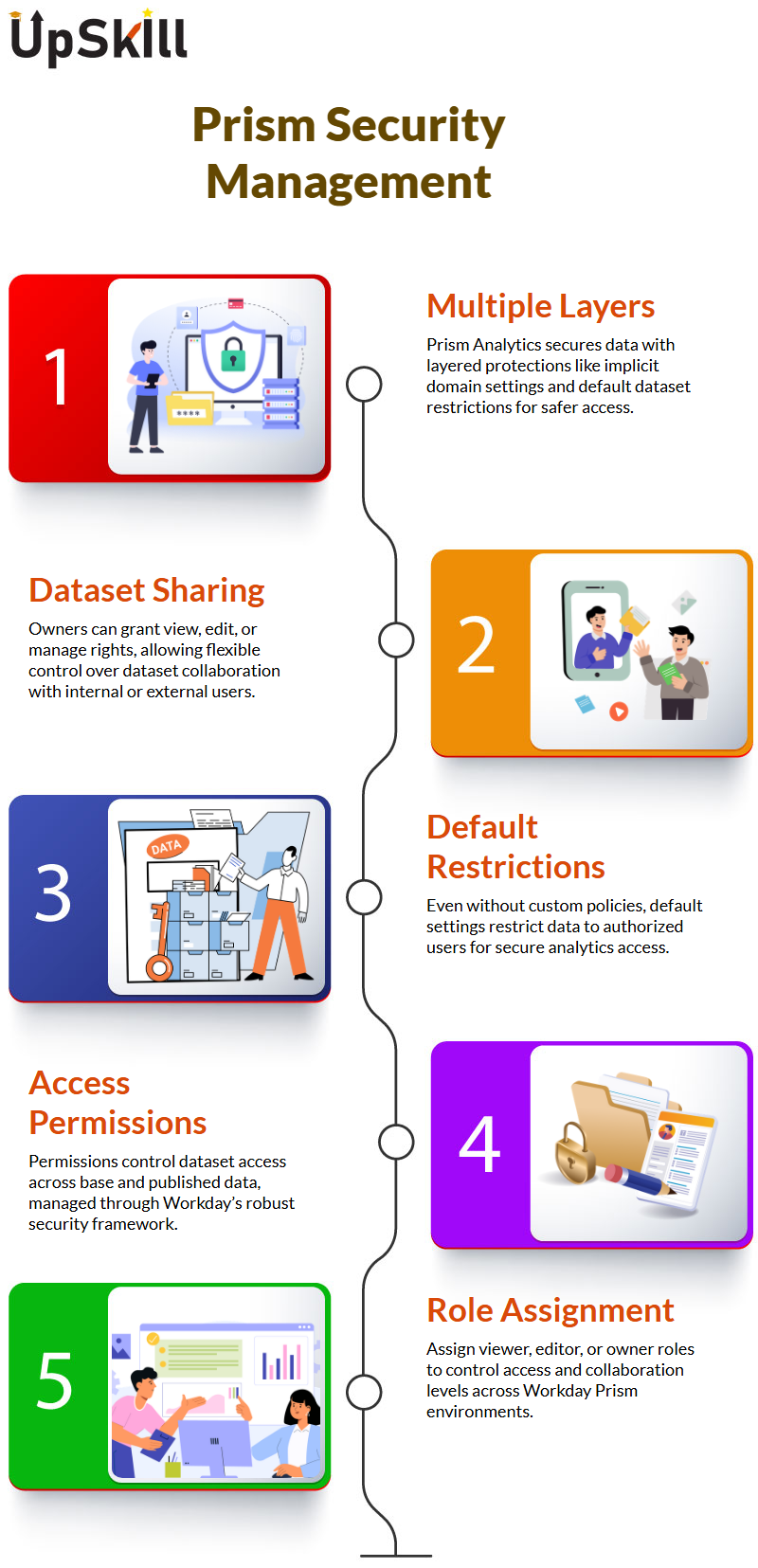
Workday Prism Analytics Security
Workday Prism Analytics Security HR administrators using Workday Prism Analytics can take advantage of an impressive security feature when accessing certain datasets; an error may arise unless their role assignees are currently members of specified security groups.
Security teams’ step in here: they determine who data sets can be shared with. If someone owns one of their datasets, it can be made accessible for users or security groups within those settings if allowed by its creator.
Workday Prism Analytics ensures maximum control. If sharing a derived data set with someone, they must have access to all base datasets feeding into it as well.
By clicking ‘view’ to quickly examine security settings, it becomes evident that sharing a derived data set means also sharing its foundational ones; that is the beauty of Workday Prism Analytics: it streamlines data-sharing procedures while strengthening them at once.
Base and Derived Data Sets in Workday Prism Analytics
Work-based security layers begin with the first level, which controls access to datasets or individual pieces within them.
Workday Prism Analytics allows for explicit security configurations on published datasets in addition to implicit settings applied by default, making publishing secure data sources possible.
Workday Prism Analytics incorporates additional layers to ensure data security according to specific organizational needs and requirements.
Domains provide security in Workday Prism Analytics Course in Bengaluru for instance, 103 can be used as a custom domain that protects one data source in particular.
Permission for this domain is assigned by the security team to ensure only approved individuals gain entry.
Workday Prism Analytics Security Architecture
Workday Prism Analytics security is built upon security groups – this classification of users who require similar access rights – as the cornerstone.
From HR managers and compensation partners, to data analysts and analytics personnel – everyone’s level of access depends upon which group their security group belongs.
For instance, two users requiring access to similar data would fall within one security group, Workday Prism Analytics Course in Bengaluru makes managing user groups and allocating roles simple so everyone receives exactly what they require.

